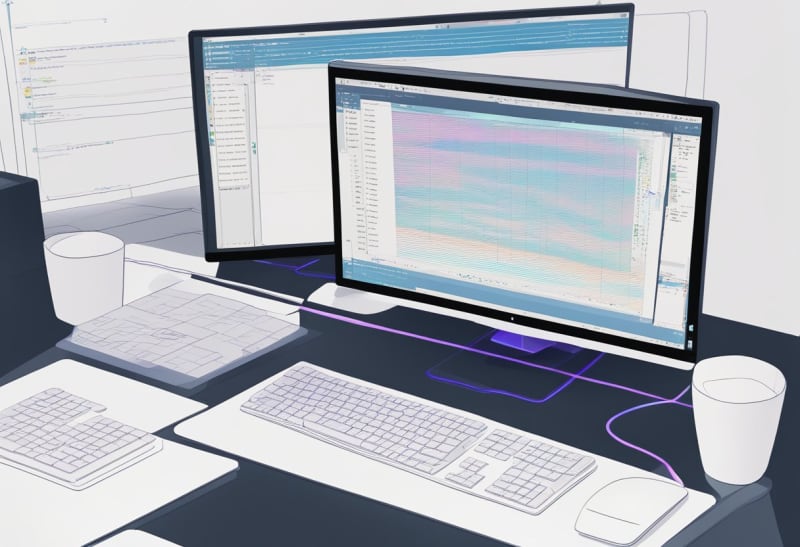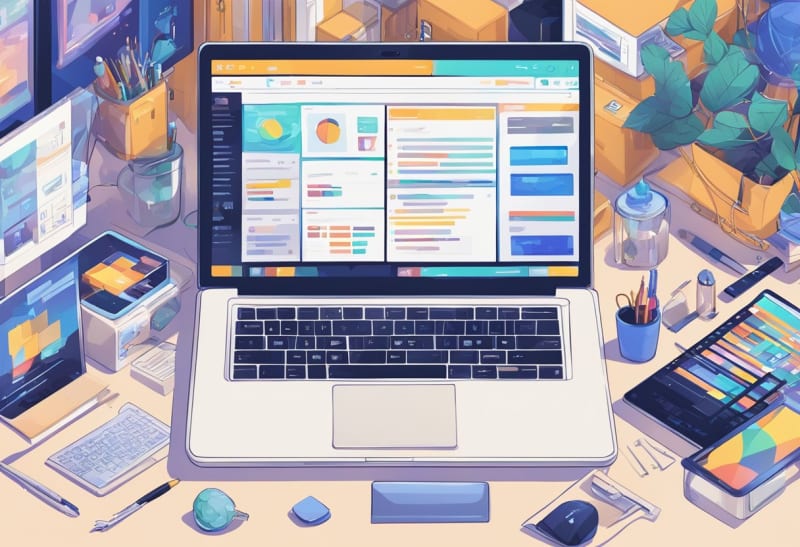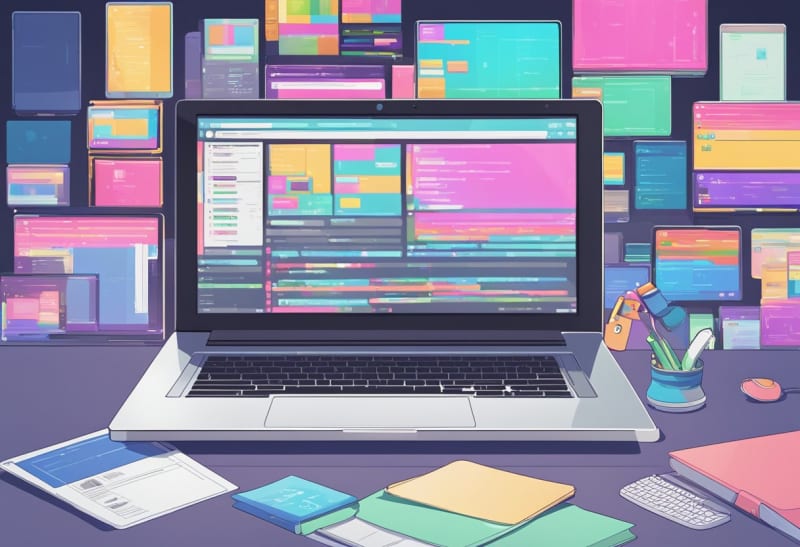掌握 CSS:卓越网页设计的基本技术
CSS is a powerful tool for creating visually appealing websites. Mastering CSS allows designers and developers to create layouts that are not only attractive but also responsive and accessible. With a solid understanding of CSS, individuals can enhance their projects and ensure they look great on any device.

To truly excel in web design, one must grasp the fundamentals of CSS, including layout techniques and advanced styling options. By exploring resources like W3Schools.com, learners can access valuable tutorials and exercises to strengthen their skills. This knowledge not only helps in creating stunning interfaces but also plays a crucial role in implementing best practices and improving website accessibility.
As developers progress, they will encounter various CSS preprocessors and frameworks that streamline the coding process. Understanding these advanced tools, along with effective testing and debugging techniques, is essential for mastering CSS and achieving professional results.
Key Takeaways
- A strong grasp of CSS fundamentals leads to better website design.
- Learning advanced techniques enhances responsiveness and accessibility.
- Familiarity with preprocessors and frameworks streamlines coding efficiency.
https://makemychance.com/html-css-and-javascript-interview-questions/
Basics of CSS

Understanding the basics of CSS is essential for styling web pages effectively. This section covers the syntax and selectors used in CSS, how to apply styles, and the use of colors and text.
Syntax and Selectors
CSS syntax consists of selectors and declarations. A selector targets HTML elements, while a declaration defines how those elements should be styled. The declaration block is enclosed in curly braces {}, containing property-value pairs.
For example, in the code below:
h1 {
color: blue;
font-size: 20px;
}
The selector h1 targets all
elements. The properties color and font-size are set to blue and 20px, respectively.
Selectors can be simple or complex. Common types include:
- Class selectors (e.g., .myClass)
- ID selectors (e.g., #myID)
- Attribute selectors (e.g., [type="text"])
Applying Styles
Applying styles in CSS involves linking a CSS file to HTML or writing styles directly in the HTML using
Example of linking a CSS file:
Inline styles can also be used for specific cases, though they are less common. For instance:
Hello World
Using HTML classes and IDs makes it easier to manage styles and apply them across multiple elements.
Colors and Text
Colors in CSS can be defined using color names, hexadecimal values, or RGB/RGBA. For instance:
- Color names: red
- Hexadecimal: #ff0000
- RGB: rgb(255,0,0)
- RGBA: rgba(255,0,0,0.5)
Text styling includes properties like font-family, font-size, and text-align. For example:
p {
font-family: Arial, sans-serif;
font-size: 16px;
text-align: center;
}
CSS also supports text decoration and transformations, like:
- Bold: font-weight: bold;
- Italic: font-style: italic;
- Underline: text-decoration: underline;
Understanding these basics helps ensure effective and appealing web design.
Layout Techniques

Layout techniques are essential for creating visually appealing and functional web pages. Understanding the key methods helps designers control the placement and behavior of elements on a website.
The Box Model
The box model is fundamental to CSS layout. It describes how elements are structured in terms of width, height, margins, borders, and padding.
- Content: The area where text and images appear.
- Padding: Space between content and its border.
- Border: A line surrounding the padding, which can vary in thickness and color.
- Margin: The outermost layer, creating space between the element and others.
By manipulating these properties, designers control how elements interact with each other. Using tools like the Chrome Developer Tools can help visualize the box model in action. Understanding this model allows for precise and efficient layout design.
Flexbox
Flexbox is a layout model that provides a way to arrange items in a one-dimensional space, either in rows or columns. This technique allows for easy alignment and distribution of space among items in a container.
Key properties include:
- display: flex: This enables flexbox on the container.
- flex-direction: This sets the direction of item placement (row, column).
- justify-content: This adjusts the spacing between items (center, space-between, etc.).
- align-items: This aligns items vertically within the container.
Flexbox is particularly useful for responsive design. It adapts layouts seamlessly to different screen sizes, providing a flexible and user-friendly approach.
Grid Layout
Grid layout is a two-dimensional layout system that allows designers to create complex and responsive layouts easily. It divides a page into rows and columns, enabling precise control over positioning.
Key features include:
- display: grid: Activates grid layout on the container.
- grid-template-columns: Defines the number and size of columns.
- grid-template-rows: Sets the number and size of rows.
- grid-area: Allows items to span multiple rows or columns.
With grid layout, designers can create layouts that were previously challenging or impossible with traditional CSS. It is excellent for creating layouts that require both symmetry and flexibility, making it a powerful tool for modern web design.
Responsive Design

Responsive design is essential for modern web development. It allows websites to adapt to different screen sizes and orientations. This section covers key techniques to achieve effective responsive design: media queries, mobile-first approach, and scalable units.
Media Queries
Media queries are a powerful feature of CSS that enable styles to change based on the device's characteristics. This includes width, height, orientation, and resolution.
Example of a Media Query:
@media (max-width: 600px) {
body {
background-color: lightblue;
}
}
In this example, the background color changes when the screen width is 600 pixels or less. Media queries help create layouts that work well on both large and small screens. They ensure that text and images remain readable and visually appealing, regardless of the device being used.
Mobile First Approach
The mobile-first approach focuses on designing for smaller screens first and then adding more features for larger screens. This method is effective because it prioritizes essential content.
Benefits of Mobile First:
- Improves performance on mobile devices.
- Reduces the amount of CSS required.
- Ensures a better user experience.
By starting with mobile, developers can create a site that loads quickly and functions well regardless of screen size. They can progressively enhance the design with additional styles for tablets and desktops later.
Scalable Units
Using scalable units in CSS makes it easier to create flexible layouts. Scalable units like percentages, ems, and rems adjust based on the user's settings. This flexibility ensures that text and images maintain their proportions across different devices.
Common Scalable Units:
- Percentages: Useful for width, allowing elements to resize relative to their parent container.
- Ems: Scale based on the font size of the element.
- Rems: Scale based on the root font size, making them more predictable.
Employing scalable units leads to a more accessible website. This is important for users who may change their device settings for better readability.
Advanced Styling

Advanced styling techniques in CSS enable designers to create engaging and interactive web experiences. Key areas include the use of pseudo-classes and pseudo-elements, animations and transitions, and effective typography. Each of these elements plays a crucial role in modern web design.
Pseudo-Classes and Pseudo-Elements
Pseudo-classes and pseudo-elements are powerful tools in CSS. They allow for styling based on the state of an element or its relationship to other elements.
Pseudo-Classes are defined with a colon (:) and change the style of an element when it is in a specific state. For example:
- :hover changes style when a user hovers over an element.
- :focus applies styles when an element is selected.
Pseudo-Elements are defined with double colons (::) and allow styling of a specific part of an element. Examples include:
- ::before and ::after can insert content before or after an element.
- ::first-line styles the first line of a block of text.
Using these techniques can significantly enhance user interaction and visual appeal.
Animations and Transitions
Animations and transitions make web pages dynamic. They help to create a smoother experience as users navigate through a site.
Transitions allow properties to change gradually over a specified duration. For example, changing the background color can look more appealing if it fades from one color to another:
.button {
transition: background-color 0.3s ease;
}
Animations define multiple keyframes, allowing for more complex movements. For instance:
@keyframes slide {
from { transform: translateX(0); }
to { transform: translateX(100px); }
}
Using animations and transitions appropriately improves user experience by drawing attention to important elements.
Typography and Web Fonts
Typography significantly impacts a website's readability and overall aesthetics. CSS supports a variety of web fonts, improving design flexibility.
Using @font-face allows designers to include custom fonts. This enhances branding and user engagement:
@font-face {
font-family: 'MyCustomFont';
src: url('MyCustomFont.woff2') format('woff2');
}
Choosing suitable font sizes and weights is essential. It's important to maintain a hierarchy, using larger sizes for headings and smaller sizes for body text.
Additionally, utilizing line height and letter spacing can improve text legibility. This careful attention to typography fosters a better user experience.
Preprocessors and Frameworks

Preprocessors and frameworks are essential tools in CSS development. They help simplify coding and enhance design capabilities, allowing developers to create responsive and efficient web applications. Key tools like Sass, LESS, Bootstrap, and Tailwind CSS offer unique features and benefits.
Sass and LESS
Sass (Syntactically Awesome Style Sheets) and LESS (Leaner Style Sheets) are popular CSS preprocessors. They add useful features like variables, nesting, and mixins, which make CSS more maintainable.
Key features of Sass:
- Variables: Store values such as colors and font sizes for reuse.
- Nesting: Organize styles hierarchically, making the CSS more readable.
- Mixins: Create reusable chunks of code that can be included in other styles.
LESS offers similar benefits with its own syntax and features. Both preprocessors compile to standard CSS, making integration into projects seamless. Developers choose based on their preferences and project requirements.
Bootstrap and Tailwind CSS
Bootstrap and Tailwind CSS are CSS frameworks that help streamline web development. They provide pre-built components and styles, allowing developers to focus on functionality rather than starting from scratch.
Bootstrap:
- Responsive Grid System: Easily create layouts that adapt to different screen sizes.
- Components: Offers a variety of UI elements like buttons, forms, and navbars.
- Customizable: Allows developers to adjust styles with a simple configuration file.
Tailwind CSS:
- Utility-First: Encourages using small utility classes to build designs directly in HTML.
- Customizability: Highly configurable, enabling developers to create unique designs.
- Responsive Design: Built-in classes allow easy adjustment for various screen sizes.
These frameworks enhance productivity and help maintain a consistent design across projects.
Best Practices

Effective CSS requires strong practices that enhance code organization and improve performance. Adhering to these guidelines helps developers create cleaner, more efficient stylesheets.
Code Organization
Organizing CSS code is essential for maintaining readability and ease of updates. A structured approach involves separating styles into logical sections. Developers should consider using comments to mark different layout components, such as headers, footers, and content areas.
A common practice is to use a naming convention like BEM (Block Element Modifier) to help clearly define relationships between selectors. This method creates consistent and predictable class names, which makes finding and modifying styles easier.
Additionally, grouping related styles together within a stylesheet reduces the effort to locate specific rules. For larger projects, using multiple stylesheets for different components can further enhance organization, making navigation systematic.
Performance Optimization
Optimization is vital in CSS to ensure fast loading and efficient rendering of web pages. Developers can start by minimizing the use of complex selectors. Simple selectors often perform better than complex ones because they require less computation when the browser renders the page.
Another important practice is to reduce CSS file sizes. This can be achieved by removing unused styles and employing tools like CSS preprocessors. These tools allow developers to combine and minify stylesheets, reducing HTTP requests and improving load times.
Using shorthand properties also helps minimize code. For example, using margin: 5px 10px; instead of specifying each side increases efficiency. Finally, loading CSS files in the head of the document can enhance rendering speed, providing a better user experience.
Accessibility and Internationalization

Accessibility in web design ensures that all users, including those with disabilities, can use a website. This includes using clear fonts, proper color contrasts, and alternative text for images.
Internationalization, on the other hand, makes a website usable for people from different cultures and languages. It involves using standard character codes, such as Unicode, to support various languages and symbols.
Here are some key practices for both accessibility and internationalization:
-
Use Semantic HTML: This helps screen readers interpret the content accurately.
-
Provide Text Alternatives: Images should have descriptive alt text to inform users.
-
Responsive Design: Websites should adapt to different devices and screen sizes.
-
Standardize Characters: Utilize Unicode Character Code Charts to ensure characters display correctly across languages.
-
Language Attributes: Use HTML language attributes to specify the language of the content.
-
CSS for Accessibility: Use CSS to improve layout and readability. Good document flow and positioning can enhance usability for all users.
By focusing on these practices, web creators can make their sites more inclusive and usable for diverse audiences.
Testing and Debugging

Testing and debugging are essential for ensuring a website functions as intended. Proper tools help identify issues in CSS and simplify the process of fixing them. The following sections will explore the use of browser developer tools and CSS linting tools.
Browser Developer Tools
Browser developer tools are built into most modern web browsers. These tools allow users to inspect CSS styles directly on a web page. By right-clicking on an element and selecting "Inspect," users can see the CSS rules applied to that element.
They can modify these rules in real-time to observe how changes impact the layout. Key features include:
- Element Inspector: View and alter HTML and CSS.
- Console: Check for errors and warnings in scripts.
- Network Monitor: Analyze resource loading and performance.
Using these features helps identify and resolve issues quickly, enhancing overall web performance and user experience.
CSS Linting Tools
CSS linting tools analyze CSS code for errors and possible improvements. They help maintain clean, efficient code by spotting mistakes early in the development process. Common linting tools include:
- CSS Lint: Checks for code quality and compatibility issues.
- Stylelint: A modern tool that supports custom rules and plugins.
These tools provide feedback, like identifying unused styles or suggesting better practices. Integrating linting into the development workflow can prevent bugs and simplify future updates, boosting productivity and code quality.
CSS in Practice

Applying CSS in real-world situations requires a solid understanding of how styles affect layout, functionality, and user experience. This section explores practical applications through real-world scenarios and relevant case studies.
Real-World Scenarios
In many projects, CSS is used to enhance user interaction. For instance, a responsive website design adjusts to different screen sizes, ensuring accessibility across devices.
A common scenario includes creating navigation menus. Developers can use CSS to style dropdowns and highlight active links, making sites more user-friendly.
Key techniques include:
- Flexbox: Ideal for layout control, allowing easy alignment of items.
- Grid: Perfect for complex layouts, offering precise control over columns and rows.
In another case, CSS animations can draw attention to important content. Subtle effects, like fading in elements on scroll, improve user engagement.
Case Studies
One notable example is the redesign of a retail website. The team applied CSS to create a vibrant, mobile-friendly layout. They implemented media queries to adapt styles based on device width, improving user navigation.
Another successful case involved a tech blog that employed CSS variables for theme customization. This allowed users to switch themes easily, enhancing personalization.
Using cascading stylesheets effectively can lead to better performance and a seamless user experience. By analyzing these cases, developers can understand how practical applications of CSS contribute to successful web projects.
Frequently Asked Questions

Many learners seek answers about mastering CSS. This section addresses common queries regarding effective learning strategies, resources, recommended reading, and the impact of CSS proficiency on web development.
What are effective strategies for learning advanced CSS techniques?
To learn advanced CSS techniques, one effective strategy is to build projects that challenge existing skills. Creating a responsive website or experimenting with animations can deepen understanding.
Participating in online communities and forums also helps. Engaging with others provides insights and different perspectives on complex topics.
How can I access resources for mastering CSS for free?
There are many free online resources available for mastering CSS. Websites like Mozilla Developer Network (MDN) offer comprehensive documentation and tutorials.
Additionally, platforms like freeCodeCamp provide hands-on coding exercises. Utilizing coding practice sites like CodePen can also enhance skills through real-time feedback.
What are some recommended books or materials for deepening knowledge in CSS?
Several books are highly regarded for deepening CSS knowledge. For instance, "CSS Mastery" is a popular choice that covers advanced techniques in depth.
Another recommendation is "AdvancED CSS," which explores modern styling practices. These books can provide both foundational and advanced insights into CSS.
Can proficiency in CSS significantly improve web development skills?
Proficiency in CSS can greatly enhance web development skills. It enables developers to create visually appealing designs that improve user experience.
Mastering CSS also facilitates collaboration with designers, as it allows for more effective communication regarding layout and styling.
How much time should I allocate to practice to become proficient in CSS?
Allocating consistent practice time is essential for proficiency in CSS. Aim for at least a few hours each week dedicated to hands-on coding.
Frequent practice leads to better retention of concepts and techniques. Short, focused sessions can be more effective than infrequent longer ones.
What are the benefits of learning CSS frameworks like Tailwind compared to traditional CSS?
Learning CSS frameworks like Tailwind offers several advantages. They provide ready-made utility classes that speed up development and improve consistency across projects.
Compared to traditional CSS, frameworks encourage a more modular approach. This can simplify maintenance and updates, making the development process more efficient.
-
 为什么PHP的DateTime :: Modify('+1个月')会产生意外的结果?使用php dateTime修改月份:发现预期的行为在使用PHP的DateTime类时,添加或减去几个月可能并不总是会产生预期的结果。正如文档所警告的那样,“当心”这些操作的“不像看起来那样直观。 考虑文档中给出的示例:这是内部发生的事情: 现在在3月3日添加另一个月,因为2月在2001年只有2...编程 发布于2025-07-10
为什么PHP的DateTime :: Modify('+1个月')会产生意外的结果?使用php dateTime修改月份:发现预期的行为在使用PHP的DateTime类时,添加或减去几个月可能并不总是会产生预期的结果。正如文档所警告的那样,“当心”这些操作的“不像看起来那样直观。 考虑文档中给出的示例:这是内部发生的事情: 现在在3月3日添加另一个月,因为2月在2001年只有2...编程 发布于2025-07-10 -
 Java的Map.Entry和SimpleEntry如何简化键值对管理?A Comprehensive Collection for Value Pairs: Introducing Java's Map.Entry and SimpleEntryIn Java, when defining a collection where each element com...编程 发布于2025-07-10
Java的Map.Entry和SimpleEntry如何简化键值对管理?A Comprehensive Collection for Value Pairs: Introducing Java's Map.Entry and SimpleEntryIn Java, when defining a collection where each element com...编程 发布于2025-07-10 -
 如何在其容器中为DIV创建平滑的左右CSS动画?通用CSS动画,用于左右运动 ,我们将探索创建一个通用的CSS动画,以向左和右移动DIV,从而到达其容器的边缘。该动画可以应用于具有绝对定位的任何div,无论其未知长度如何。问题:使用左直接导致瞬时消失 更加流畅的解决方案:混合转换和左 [并实现平稳的,线性的运动,我们介绍了线性的转换。这...编程 发布于2025-07-10
如何在其容器中为DIV创建平滑的左右CSS动画?通用CSS动画,用于左右运动 ,我们将探索创建一个通用的CSS动画,以向左和右移动DIV,从而到达其容器的边缘。该动画可以应用于具有绝对定位的任何div,无论其未知长度如何。问题:使用左直接导致瞬时消失 更加流畅的解决方案:混合转换和左 [并实现平稳的,线性的运动,我们介绍了线性的转换。这...编程 发布于2025-07-10 -
 Go web应用何时关闭数据库连接?在GO Web Applications中管理数据库连接很少,考虑以下简化的web应用程序代码:出现的问题:何时应在DB连接上调用Close()方法?,该特定方案将自动关闭程序时,该程序将在EXITS EXITS EXITS出现时自动关闭。但是,其他考虑因素可能保证手动处理。选项1:隐式关闭终止数...编程 发布于2025-07-10
Go web应用何时关闭数据库连接?在GO Web Applications中管理数据库连接很少,考虑以下简化的web应用程序代码:出现的问题:何时应在DB连接上调用Close()方法?,该特定方案将自动关闭程序时,该程序将在EXITS EXITS EXITS出现时自动关闭。但是,其他考虑因素可能保证手动处理。选项1:隐式关闭终止数...编程 发布于2025-07-10 -
 Python中何时用"try"而非"if"检测变量值?使用“ try“ vs.” if”来测试python 在python中的变量值,在某些情况下,您可能需要在处理之前检查变量是否具有值。在使用“如果”或“ try”构建体之间决定。“ if” constructs result = function() 如果结果: 对于结果: ...编程 发布于2025-07-10
Python中何时用"try"而非"if"检测变量值?使用“ try“ vs.” if”来测试python 在python中的变量值,在某些情况下,您可能需要在处理之前检查变量是否具有值。在使用“如果”或“ try”构建体之间决定。“ if” constructs result = function() 如果结果: 对于结果: ...编程 发布于2025-07-10 -
 Async Void vs. Async Task在ASP.NET中:为什么Async Void方法有时会抛出异常?在ASP.NET async void void async void void void void void的设计无需返回asynchroncon而无需返回任务对象。他们在执行过程中增加未偿还操作的计数,并在完成后减少。在某些情况下,这种行为可能是有益的,例如未期望或明确预期操作结果的火灾和...编程 发布于2025-07-10
Async Void vs. Async Task在ASP.NET中:为什么Async Void方法有时会抛出异常?在ASP.NET async void void async void void void void void的设计无需返回asynchroncon而无需返回任务对象。他们在执行过程中增加未偿还操作的计数,并在完成后减少。在某些情况下,这种行为可能是有益的,例如未期望或明确预期操作结果的火灾和...编程 发布于2025-07-10 -
 在C#中如何高效重复字符串字符用于缩进?在基于项目的深度下固定字符串时,重复一个字符串以进行凹痕,很方便有效地有一种有效的方法来返回字符串重复指定的次数的字符串。使用指定的次数。 constructor 这将返回字符串“ -----”。 字符串凹痕= new String(' - ',depth); console.Wr...编程 发布于2025-07-10
在C#中如何高效重复字符串字符用于缩进?在基于项目的深度下固定字符串时,重复一个字符串以进行凹痕,很方便有效地有一种有效的方法来返回字符串重复指定的次数的字符串。使用指定的次数。 constructor 这将返回字符串“ -----”。 字符串凹痕= new String(' - ',depth); console.Wr...编程 发布于2025-07-10 -
 Java中如何使用观察者模式实现自定义事件?在Java 中创建自定义事件的自定义事件在许多编程场景中都是无关紧要的,使组件能够基于特定的触发器相互通信。本文旨在解决以下内容:问题语句我们如何在Java中实现自定义事件以促进基于特定事件的对象之间的交互,定义了管理订阅者的类界面。以下代码片段演示了如何使用观察者模式创建自定义事件: args)...编程 发布于2025-07-10
Java中如何使用观察者模式实现自定义事件?在Java 中创建自定义事件的自定义事件在许多编程场景中都是无关紧要的,使组件能够基于特定的触发器相互通信。本文旨在解决以下内容:问题语句我们如何在Java中实现自定义事件以促进基于特定事件的对象之间的交互,定义了管理订阅者的类界面。以下代码片段演示了如何使用观察者模式创建自定义事件: args)...编程 发布于2025-07-10 -
 Go语言垃圾回收如何处理切片内存?Garbage Collection in Go Slices: A Detailed AnalysisIn Go, a slice is a dynamic array that references an underlying array.使用切片时,了解垃圾收集行为至关重要,以避免潜在的内存泄...编程 发布于2025-07-10
Go语言垃圾回收如何处理切片内存?Garbage Collection in Go Slices: A Detailed AnalysisIn Go, a slice is a dynamic array that references an underlying array.使用切片时,了解垃圾收集行为至关重要,以避免潜在的内存泄...编程 发布于2025-07-10 -
 如何处理PHP文件系统功能中的UTF-8文件名?在PHP的Filesystem functions中处理UTF-8 FileNames 在使用PHP的MKDIR函数中含有UTF-8字符的文件很多flusf-8字符时,您可能会在Windows Explorer中遇到comploreer grounder grounder grounder gro...编程 发布于2025-07-10
如何处理PHP文件系统功能中的UTF-8文件名?在PHP的Filesystem functions中处理UTF-8 FileNames 在使用PHP的MKDIR函数中含有UTF-8字符的文件很多flusf-8字符时,您可能会在Windows Explorer中遇到comploreer grounder grounder grounder gro...编程 发布于2025-07-10 -
 表单刷新后如何防止重复提交?在Web开发中预防重复提交 在表格提交后刷新页面时,遇到重复提交的问题是常见的。要解决这个问题,请考虑以下方法: 想象一下具有这样的代码段,看起来像这样的代码段:)){ //数据库操作... 回声“操作完成”; 死(); } ?> ...编程 发布于2025-07-10
表单刷新后如何防止重复提交?在Web开发中预防重复提交 在表格提交后刷新页面时,遇到重复提交的问题是常见的。要解决这个问题,请考虑以下方法: 想象一下具有这样的代码段,看起来像这样的代码段:)){ //数据库操作... 回声“操作完成”; 死(); } ?> ...编程 发布于2025-07-10 -
 CSS可以根据任何属性值来定位HTML元素吗?靶向html元素,在CSS 中使用任何属性值,在CSS中,可以基于特定属性(如下所示)基于特定属性的基于特定属性的emants目标元素: 字体家庭:康斯拉斯(Consolas); } 但是,出现一个常见的问题:元素可以根据任何属性值而定位吗?本文探讨了此主题。的目标元素有任何任何属性值,属...编程 发布于2025-07-10
CSS可以根据任何属性值来定位HTML元素吗?靶向html元素,在CSS 中使用任何属性值,在CSS中,可以基于特定属性(如下所示)基于特定属性的基于特定属性的emants目标元素: 字体家庭:康斯拉斯(Consolas); } 但是,出现一个常见的问题:元素可以根据任何属性值而定位吗?本文探讨了此主题。的目标元素有任何任何属性值,属...编程 发布于2025-07-10 -
 PHP阵列键值异常:了解07和08的好奇情况PHP数组键值问题,使用07&08 在给定数月的数组中,键值07和08呈现令人困惑的行为时,就会出现一个不寻常的问题。运行print_r($月)返回意外结果:键“ 07”丢失,而键“ 08”分配给了9月的值。此问题源于PHP对领先零的解释。当一个数字带有0(例如07或08)的前缀时,PHP将其...编程 发布于2025-07-10
PHP阵列键值异常:了解07和08的好奇情况PHP数组键值问题,使用07&08 在给定数月的数组中,键值07和08呈现令人困惑的行为时,就会出现一个不寻常的问题。运行print_r($月)返回意外结果:键“ 07”丢失,而键“ 08”分配给了9月的值。此问题源于PHP对领先零的解释。当一个数字带有0(例如07或08)的前缀时,PHP将其...编程 发布于2025-07-10 -
 在Ubuntu/linux上安装mysql-python时,如何修复\“ mysql_config \”错误?mysql-python安装错误:“ mysql_config找不到”“ 由于缺少MySQL开发库而出现此错误。解决此问题,建议在Ubuntu上使用该分发的存储库。使用以下命令安装Python-MysqldB: sudo apt-get安装python-mysqldb sudo pip in...编程 发布于2025-07-10
在Ubuntu/linux上安装mysql-python时,如何修复\“ mysql_config \”错误?mysql-python安装错误:“ mysql_config找不到”“ 由于缺少MySQL开发库而出现此错误。解决此问题,建议在Ubuntu上使用该分发的存储库。使用以下命令安装Python-MysqldB: sudo apt-get安装python-mysqldb sudo pip in...编程 发布于2025-07-10 -
 在Java中使用for-to-loop和迭代器进行收集遍历之间是否存在性能差异?For Each Loop vs. Iterator: Efficiency in Collection TraversalIntroductionWhen traversing a collection in Java, the choice arises between using a for-...编程 发布于2025-07-10
在Java中使用for-to-loop和迭代器进行收集遍历之间是否存在性能差异?For Each Loop vs. Iterator: Efficiency in Collection TraversalIntroductionWhen traversing a collection in Java, the choice arises between using a for-...编程 发布于2025-07-10
学习中文
- 1 走路用中文怎么说?走路中文发音,走路中文学习
- 2 坐飞机用中文怎么说?坐飞机中文发音,坐飞机中文学习
- 3 坐火车用中文怎么说?坐火车中文发音,坐火车中文学习
- 4 坐车用中文怎么说?坐车中文发音,坐车中文学习
- 5 开车用中文怎么说?开车中文发音,开车中文学习
- 6 游泳用中文怎么说?游泳中文发音,游泳中文学习
- 7 骑自行车用中文怎么说?骑自行车中文发音,骑自行车中文学习
- 8 你好用中文怎么说?你好中文发音,你好中文学习
- 9 谢谢用中文怎么说?谢谢中文发音,谢谢中文学习
- 10 How to say goodbye in Chinese? 再见Chinese pronunciation, 再见Chinese learning

























